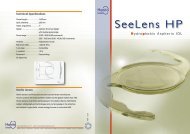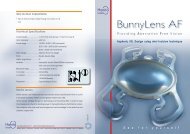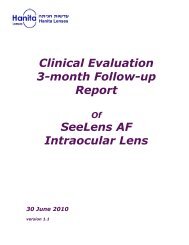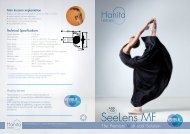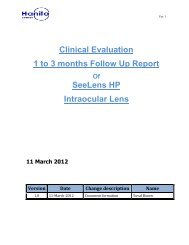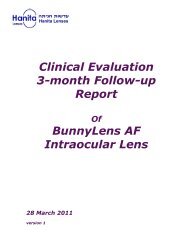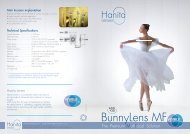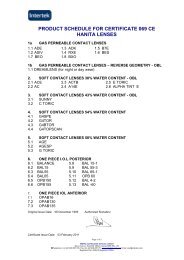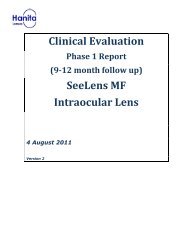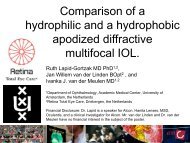Clinical Evaluation 3-month Follow-up Report Of ... - Hanita Lenses
Clinical Evaluation 3-month Follow-up Report Of ... - Hanita Lenses
Clinical Evaluation 3-month Follow-up Report Of ... - Hanita Lenses
- No tags were found...
Create successful ePaper yourself
Turn your PDF publications into a flip-book with our unique Google optimized e-Paper software.
עדשות חניתה<strong>Hanita</strong> <strong>Lenses</strong>5of 16Figure 2:The Black line defines the photopic vision and the green line defines the scotopic vision.The area between the graphs defines the scotopic vision.b. Hydrophobic material – preventing PCO:The SeeLens HP is made of hydrophobic acrylic material, which is known to be s<strong>up</strong>erior inpostponing the posterior capsular opacification (PCO), thus reducing the need for the YAGlaser treatment. Moreover, hydrophobic materials are known to be more stable within theposterior capsule with respect to the hydrophilic lenses due to its higher stiffness with respectto the hydrophilic acrylic material. The SeeLens HP aspheric optical design is identical to theSeeLens AF, <strong>Hanita</strong> <strong>Lenses</strong>’ premium product. The SeeLens HP is made of a different rawmaterial, BENZ HF-1 Natural Yellow. This material has chemical composition very similar tothe backbone structure of the BENZ IOL 25 Natural Yellow material.c. Spherical aberration:The spherical aberration is a well known phenomenon in the optic field. The sphericalaberration occurs when rays of light that pass through different parts of the lens intersect atdifferent points on the optical axis of the lens (Figure 3). Due to this aberration, a dotprojected on the retina produces a larger circle, thus inducing low quality optics, an unclearvision and low contrast (Figure 4).Figure 3:Spherical AberrationFigure 4:A demonstration of the blur caused by spherical aberration with awider p<strong>up</strong>il. The rays that enter the retina from far scatter differentlyand are projected blurredly to the retina, causing a law quality image.Contributors to spherical aberration (SA) in the eye are the cornea (average +0.27 m) and thecrystalline lens (negative in the young eye). Cataract surgery removes the lens component andleaves positive SA on average. Traditional intraocular lenses (IOLs) are spherical withpositive SA, further increasing the SA of the pseudophakic eye.<strong>Hanita</strong> <strong>Lenses</strong> Intraocular & Contact <strong>Lenses</strong>עדשות חניתהעדשות מגע ועדשות השתלה תוך-עינית•קיבוץ חניתה • 88885 www.hanitalenses.com Kibbutz <strong>Hanita</strong> 22885 Israel • Tel. 972-4-9950 700• Fax: 972-4-9950 755 •



